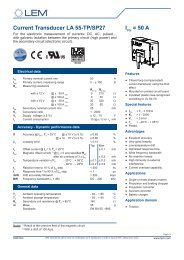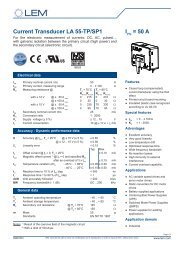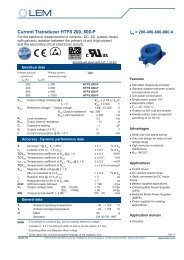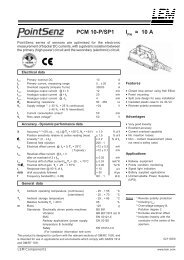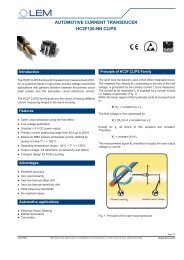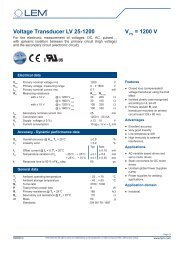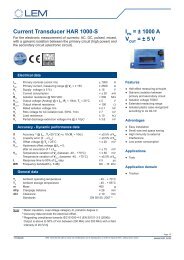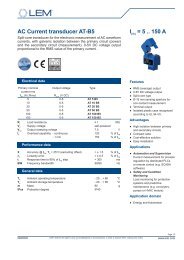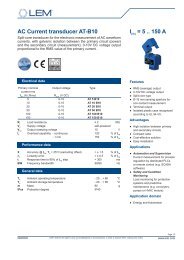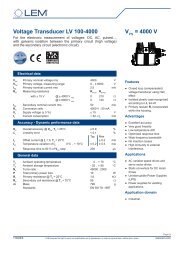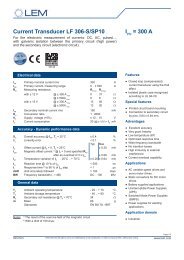DI Series Shunt Isolator - LEM
DI Series Shunt Isolator - LEM
DI Series Shunt Isolator - LEM
Create successful ePaper yourself
Turn your PDF publications into a flip-book with our unique Google optimized e-Paper software.
DC & AC Class accuracy R Current Measurement<br />
<strong>DI</strong> series <strong>Shunt</strong> <strong>Isolator</strong><br />
ITC series Current Transducers<br />
Measure DC and AC currents with a Class accuracy R (Railway)<br />
Market regulations require improvements for Railway<br />
Energy Billing.<br />
• European rail freight markets are liberalized (privatization<br />
of the rail networks into infrastructure and operators)<br />
• Since the beginning of January 2010 passenger rail<br />
markets are opened to cross-border competition<br />
Liberalization of European railway markets leads to:<br />
• new competitors in each national market<br />
• increasing cross-border traffic<br />
• new situation concerning intra- und inter-modal<br />
competition<br />
• rising demands in terms of cost transparency (exact<br />
electricity consumption must be invoiced)<br />
Traction Units consume energy in different countries along<br />
their way:<br />
• Railway Undertaking (RU) have contractual relationships<br />
with the respective Infrastructure Manager (IM)<br />
• In order to be able to transparently bill the energy<br />
consumption, the RU will need information regarding<br />
each border crossing<br />
• The IM has to invoice the RU for the supply of energy<br />
The on-board Energy Measuring System (EMS) is the<br />
system for measurement of electric energy taken from or<br />
returned (during regenerative braking) to the overhead<br />
contact line (OCL) by the traction unit, supplied from the<br />
external electric traction system.<br />
This energy measurement allows the operators to better<br />
understand their real consumption and will enable energy<br />
management to reduce energy consumption for example.<br />
The Energy Measurement Function (EMF), includes voltage<br />
and current measurement.<br />
The new EN 50463 standard defines characteristics<br />
of transducers for current and voltage DC or AC<br />
measurement as well as the energy measurement function.<br />
2<br />
In order to fulfill this standard, <strong>LEM</strong> proposes different<br />
solutions for current and voltage measurements:<br />
• DV family for DC voltage measurement Class 0.5R for a<br />
single network voltage<br />
• <strong>DI</strong> family (to be used with a shunt Class 0.2) for DC<br />
current measurement Class 1R<br />
• ITC family for DC current measurement Class 0.5R<br />
Common features:<br />
• Measurement of all types of signals: DC, AC, pulsed and<br />
complex<br />
• Compact size<br />
• High galvanic insulation between primary (high power)<br />
and secondary circuits (electronic circuit)<br />
• Low consumption technology<br />
• Excellent accuracy to suit to high demanding<br />
applications such as energy metering<br />
• Low temperature drift of accuracy<br />
• High insulation and partial discharge levels in order to<br />
guarantee safety<br />
• Good immunity against external electric, magnetic and<br />
electromagnetic fields for EMC protection<br />
• Low level of emission<br />
• Compliant to fire and smoke, mandatory in railway<br />
applications<br />
• Low influence of common mode voltage<br />
• Fast response time<br />
• Large bandwidth<br />
• Low noise<br />
• Modular approach allows easy adaptation with various<br />
connections available for the secondary side like<br />
connectors, shielded cables, terminals (threaded studs,<br />
M4, M5, UNC ect) according to customer specifications<br />
• Reliability and lifetime are guaranteed by the quality in<br />
design and process and ageing tests




